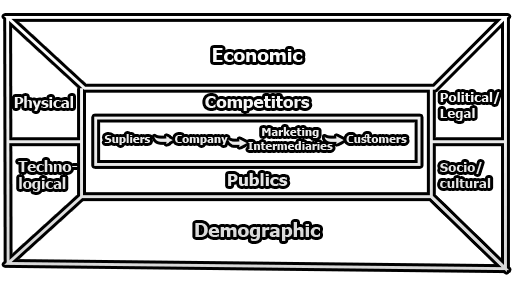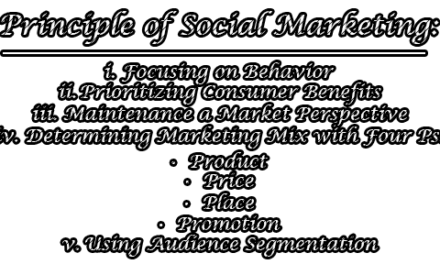Key Elements of Environmental Marketing:
The elements of the world beyond the company which is of interest to marketers are referred to collectively as the marketing environment. The external actors and forces affect the companies’ ability to develop and maintain successful transactions and relationships with their target customers. In this article, we are going to know about the Key Elements of Environmental Marketing.
From the marketing environment comes the demand for the goods and services to the company products, the resources inputs it depends upon, and the competitors and constraints that it faces. An important role of the marketing philosophy and function within a company is to make it “outward-looking” so that it confronts and responds to the world beyond factory gates. This forces the vision of the company to move beyond the familiar and controllable internal environment to focus on a world beyond, which can often seem bewildering, unpredictable, and hostile. These forces are shown in the below figure:
This figure shows an overview of the marketing environment. There are four main ways in which the behavior of the forces and actors in marketing can affect a company’s ability to deliver customer satisfaction at a profit. These ways are:
- By affecting the extent or the nature of the demand for the goods or services of a business.
- By changing the production economics or production methods available to a business.
- By altering the ability of a business to satisfy the needs of its consumers in comparison to its competitors.
- By altering the viability of the company as a whole in terms of its social, political, and legal acceptability and economic health.
True to the spirit of holism, the marketing environment should be thought of as an interconnected whole. In practice, dealing with it is made simpler by subdividing the environment into two parts. These are-
(A) Different parties within the microenvironment (those which influence and interact with the company directly and regularly).
(B) Elements of the macro environment (the wider social and environmental context whose force helps to shape developments within the microenvironment).
(A) The forces of microenvironment: The forces of the microenvironment are very much related to the company, and it is very close to the company. These forces are illustrated below:
- Customers: The most important of all the players in the market is the customer, around whose wants and needs all the marketing efforts to revolve.
- Competitors: After legislation and the customer, competition is the next most important external influence on environmental marketing.
- Suppliers: Marketers’ concern about suppliers has traditionally been twofold.
- Marketing intermediaries: The majority of manufacturers rely on other companies to distribute and sell the product to the customer.
- Local communities: The increasing scale of a business can lead them to dominate the communities within which they operate.
- Government: Environmental degradation has become a major issue on the agenda for governments all over the world.
- Media organizations: The environment has become increasingly visible as a media issue. The media have been particularly vociferous in saving companies whose high-profile environmental performance has been exposed as relatively one-dimensional.
- Investors: The relationship between investors and companies varies from country to country. Although green represent a small minority of total investment, the public relations implication of green investment decision can be disproportionately large.
- Financial institutions: Banks, large and small play an important part in the financial control of businesses and the development of projects. Like retailers, they have a role as gatekeepers and influencers.
- Insurance companies: Environmental risk is coming to dominate the thoughts of insurance companies, and is reflected in the insurance bills that a company receives.
- Interest groups: There is a wide range of groups with some form of interest in the environment. While some will be local and linked to a specific issue, others will be global and will span across the spectrum of green causes.
(B) Macro environmental forces: The macro environment of a business is difficult to analyze since it contains no clear-cut boundaries. The most common forces of the macro environment are mentioned here:
- Social dimensions: Demographic changes have always affected consumption patterns and marketing activities, and it looks set to become increasingly important in determining the fact of humankind.
- Cultural dimensions: Within society, decisions about people’s lifestyles, spending, consumption, investment, employment, and political activities are influenced by a range of cultural values and beliefs which are shared generally and among specific groups.
- Economic dimensions: The interaction between economic development and environmental degradation became increasingly clear during the 1990s. In many industries, the increasing costs of environmentally related activities such as waste disposal, emission reduction, and the cleaning of contaminated sites limit the opportunities for economic growth.
- Technological dimensions: Technological advances help companies to develop in many aspects. It is expected that technological advancement will solve the environmental problem.
- International dimensions: The marketing environment which companies address is increasingly international in nature. Green issues frequently need to be considered on an international level since environmental processes do not conform to human geographical boundaries.
- Communications and infrastructure dimensions: The development of new transport infrastructure has been crucial in creating the high-speed and delocalized marketing and distribution system that exists today. Changes to the transport infrastructure have also been instrumented in environmental degradation.
- Administrative and institutional dimensions: There is a vast array of non-government institutions which are becoming increasingly interested in the environment and environmental impact of companies.
- Legal and political dimensions: Environmental law and policy instruments are becoming an increasingly important influence on business and trade. Green political parties have had a major impact on the political sense without actually gaining access to any significant degree of political power.

Library Lecturer at Nurul Amin Degree College










